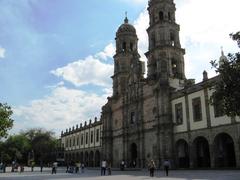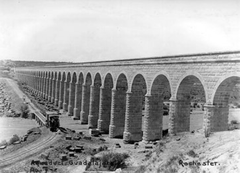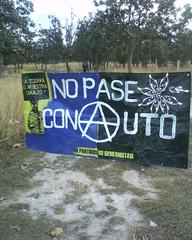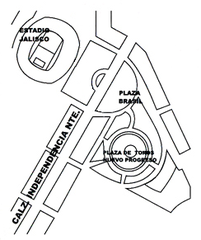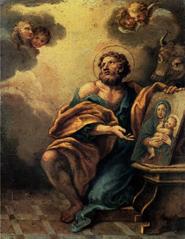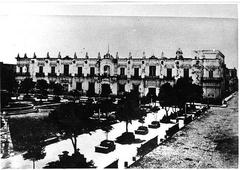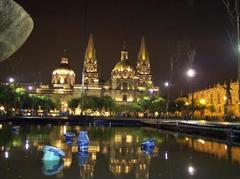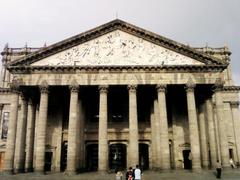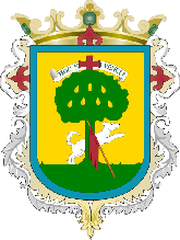Museo Regional de la Cerámica: Visiting Hours, Tickets, and Comprehensive Guide to Tlaquepaque Historical Sites
Date: 04/07/2025
Introduction
The Museo Regional de la Cerámica is a cultural cornerstone nestled in the heart of San Pedro Tlaquepaque, just outside Guadalajara, Jalisco, Mexico. Established in 1954 by the Instituto Nacional de Antropología e Historia (INAH), the museum preserves and celebrates the region’s centuries-old ceramic traditions while showcasing the living heritage of Jalisco’s artisans. The city’s name, Tlaquepaque, derived from the Nahuatl “tlalipac” meaning “place above clay land,” reflects its deep-rooted connection to ceramics—a tradition predating the Spanish conquest (Trek Zone, Mexico Travel Secrets).
Housed in a beautifully restored 19th-century colonial mansion, the museum immerses visitors in the artistry of local techniques like barro bruñido (burnished clay), petatillo (fine cross-hatching), and betus (resin-glazed clay). It also honors the legacy of Tlaquepaque’s renowned artisan families, such as the Barnabé, Jimón, Pajarito, and Panduro lineages. Through educational programs, workshops, and community engagement, the museum plays an active role in sustaining and evolving Mexico’s ceramic arts (101museos.com, Playas y Plazas).
This guide provides detailed information on visiting hours, tickets, accessibility, nearby attractions, and practical tips to help you maximize your experience at the Museo Regional de la Cerámica, while exploring the vibrant historical sites of Tlaquepaque.
Quick Facts
- Location: Independencia 237, Centro, San Pedro Tlaquepaque, Jalisco, Mexico
- Opening Hours: Tuesday to Sunday, 10:00 AM – 6:00 PM; closed Mondays
- Admission: General MXN 50; Students/Seniors MXN 25; Children under 12 free (some sources note free admission—verify before your visit)
- Accessibility: Wheelchair accessible with ramps and accessible restrooms
- Nearby Landmarks: El Parián plaza, Tlaquepaque artisan markets, Pantaleón Panduro Museum
- Photography: Permitted (no flash)
(101museos.com, Lonely Planet)
History and Cultural Significance
The museum was founded to protect and promote the unique ceramic traditions of Jalisco, which are deeply woven into the region’s identity. Tlaquepaque’s reputation as a ceramics epicenter is supported by generations of artisan families who have refined their techniques and styles, ensuring the living transmission of knowledge and skill (Trek Zone). The city’s designation as a Pueblo Mágico in 2018 underscores its cultural, historical, and artistic value (Mexico Travel Secrets).
The museum not only preserves the region’s tangible heritage through its collections, but also fosters community pride and innovation through educational outreach, workshops, and collaborative exhibitions with other institutions such as the Pantaleón Panduro Museum.
Collections and Artistic Highlights
Traditional Jalisco Ceramics
- Barro Bruñido: Burnished clay polished to a glossy finish, decorated with mineral pigments.
- Petatillo: Features dense crosshatch backgrounds with intricate, hand-painted motifs.
- Betus: Clay pieces coated with betus tree resin, giving a glossy, vibrant finish.
Historic and Contemporary Works
The museum’s exhibits span from pre-Hispanic vessels and colonial-era wares to 18th- and 19th-century masterpieces and contemporary innovations. Notable displays include:
- Pre-Hispanic Figurines: Pottery used in daily life and rituals, often adorned with symbolic motifs.
- Colonial-Influenced Ceramics: Blending indigenous and European styles.
- Contemporary Pieces: Showcasing new forms, glazes, and collaborations with modern artists (victordzul.com, wikipedia.org).
Renowned Artisan Families
- Panduro Family: Masters of figurines and petatillo.
- Jimón Family: Known for petatillo ceramics.
- Barnabé & Pajarito Families: Distinguished for barro bruñido and animal motifs (101museos.com).
Indigenous and National Diversity
Dedicated sections feature Huichol (Wixarika) art and the crafts of other indigenous groups, such as the Nahua, Mixtec, Purépecha, and Otomí, broadening the museum’s cultural context.
Thematic Rooms
- Traditional Kitchen: A reconstructed Mexican kitchen, filled with period ceramics, illustrates pottery’s role in daily life (Lonely Planet).
- Temporary Exhibitions: Regularly updated, these highlight contemporary artists, specific techniques, or themes relevant to Mexican culture.
Artistic Techniques Demonstrated
- Petatillo: Red, green, and white crosshatch backgrounds with flora and fauna scenes.
- Bruñido: Polished, unglazed surfaces adorned with mineral pigments.
- Barro Betus: Glossy, resin-coated ceramics popular for playful figurines.
- High-Temperature Ceramics: Durable, glazed wares fired above 1,200°C.
- Barro Bandera & Polychrome: Pieces in Mexican flag colors or with multicolored, intricate designs.
- Blown Glass: Regional glasswork displayed alongside ceramics (programadestinosmexico.com, mexicotravelandleisure.com).
Special Programs and Events
- Workshops & Demonstrations: Hands-on activities for all ages, especially during festivals like the Feria Nacional de la Cerámica.
- Guided Tours: Available on request and recommended for deeper context.
- Cultural Festivals: The museum partners in local celebrations, offering thematic exhibitions, artisan demonstrations, and live music (Mexico Travel Secrets).
Visitor Experience & Amenities
- Layout: Exhibition rooms surround a central colonial courtyard, with clear signage and some bilingual panels.
- Accessibility: Ramps and wide doorways accommodate wheelchairs and strollers.
- Facilities: Restrooms on site; no café, but vibrant eateries and artisan shops are steps away.
- Parking: Public lots and street parking nearby.
- Museum Shop: Locally made ceramics available for purchase; for a wider selection, visit surrounding artisan markets.
Practical Tips
- Best Time to Visit: Mornings are quieter; visiting during festivals provides extra activities.
- Language: Most signage is in Spanish; bring a translation app if needed.
- Length of Visit: Typically 1–1.5 hours, longer if participating in workshops.
- Safety: Tlaquepaque is tourist-friendly—stay aware of personal belongings.
- Cash: Many local shops/cafés accept only Mexican pesos in smaller denominations.
Nearby Attractions & Tlaquepaque Historical Sites
- El Parián Plaza: Mariachi, local cuisine, and lively atmosphere.
- Centro Cultural El Refugio: Concerts, plays, and art exhibitions.
- Museo Pantaleón Panduro: Celebrates the National Ceramics Prize.
- Artisan Markets & Galleries: Perfect for souvenirs and local art.
- Local Landmarks: The Tlaquepaque sign, Parroquia de San Pedro Apostol, and Monumento a los Niños Héroes.
Frequently Asked Questions (FAQ)
Q: What are the Museo Regional de la Cerámica visiting hours?
A: Tuesday to Sunday, 10:00 AM to 6:00 PM. Closed Mondays (Lonely Planet).
Q: How much are tickets?
A: General admission is MXN 50; students and seniors pay MXN 25; children under 12 enter free. Some sources report free admission—check before your visit (mexicouniversal.com).
Q: Is the museum wheelchair accessible?
A: Yes, with ramps and accessible restrooms.
Q: Are guided tours available?
A: Yes, upon request; group tours and workshops are best reserved in advance.
Q: Can I take photographs?
A: Photography is allowed without flash or tripods.
Q: Are there souvenirs for sale?
A: The museum shop offers ceramics, while nearby artisan shops provide a wider variety.
Q: When is the best time to visit?
A: Weekday mornings are quiet; festival periods offer enhanced experiences.
Q: Are pets allowed?
A: Only service animals are permitted.
Visuals and Media
For an enhanced experience, explore virtual tours and photo galleries on the museum’s official website and local tourism platforms. High-quality images of the colonial architecture, signature ceramic pieces (barro bruñido, petatillo), and artisan markets will deepen your appreciation. Use alt text with keywords such as “Museo Regional de la Cerámica de Tlaquepaque visiting hours” and “traditional Jalisco ceramics” for accessibility.
Conclusion and Call to Action
The Museo Regional de la Cerámica is more than a museum—it’s a vibrant center for Mexican ceramic artistry and culture. Its rich collections, engaging programs, and beautiful setting make it a must-visit for anyone seeking to understand the heart of Tlaquepaque’s—and Mexico’s—artisanal heritage. To optimize your visit, plan around the museum’s hours, explore nearby historical sites, and take advantage of tours and workshops. For up-to-date information, consult the museum’s official channels, and download the Audiala app for more cultural guides and real-time updates.
References and Further Reading
- Museo Regional De La Cerámica in Tlaquepaque: Visiting Hours, Tickets & Cultural Highlights, Audiala Travel Blog
- Museo Regional de la Cerámica in Tlaquepaque: Visiting Hours, Tickets, and Cultural Insights, Trek Zone & Mexico Travel Secrets, Mexico Travel Secrets
- Museo Regional de la Cerámica Tlaquepaque: Visiting Hours, Ticket Information, and Collection Highlights, 101museos, Programadestinosmexico & Lonely Planet, Programadestinosmexico, Lonely Planet
- Museo Regional de la Cerámica de Tlaquepaque Visiting Hours, Tickets, and Visitor Guide to Tlaquepaque Historical Sites, Mexicouniversal & Playasyplazas, Playasyplazas
